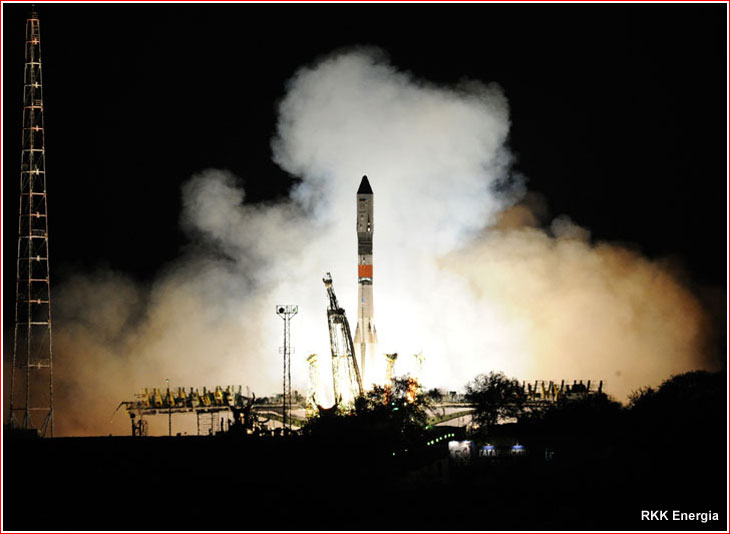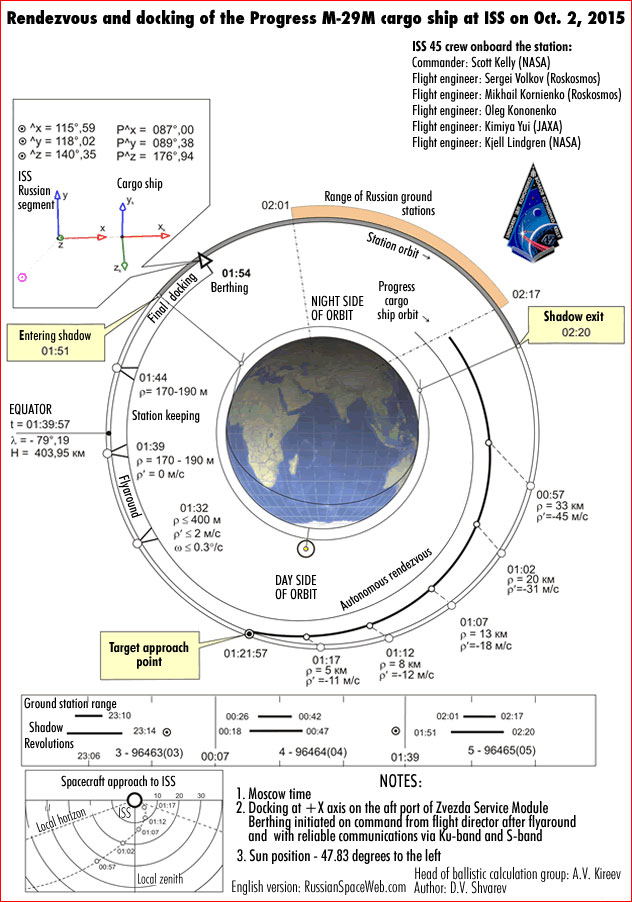Progress M-29M (original) (raw)
Progress M-29M arrives at ISS
The Progress M-29M became the fourth Russian cargo ship heading to the International Space Station, ISS, in 2015. The spacecraft has a production number 429 and it is also known in the ISS flight manifest as Mission 61P. The ship is expected to be the final vehicle in the series, before the planned introduction of the modified variant known as Progress-MS later this year.
Previous mission: Progress M-28M

Launch sequence for the Progress M-29M mission on Oct. 1, 2015.
From the publisher: Pace of our development depends primarily on the level of support from our readers!
Preparations for the mission
According to Roskosmos, Progress M-29M will carry a total of 2,369 kilograms of provisions, including 1,549 kilograms of dry cargo, 350 kilograms of propellant, 420 kilograms of water, 50 kilograms of pressurized oxygen, as well as other supplies and repair gear.
The launch was previously scheduled for Sept. 21, 2015, but by the end of July, the mission had to be postponed to October 1, as part of the ISS manifest adjustment.
The first and second stages of the Soyuz-U launch vehicle for the mission were integrated inside the processing building at Site 112 by the end of July 2015.
The Progress M-29M spacecraft loaded with its onboard propellant arrived to the processing building at Site 254 on Sept. 22, 2015. Within two days, it was integrated with the launch vehicle adapter and on Sept. 25, the ship was covered with a payload fairing. Two days later, the fully encapsulated spacecraft was moved to Site 112 for integration with the launch vehicle. On September 28, the spacecraft and the rocket were mated together.
The launch vehicle was rolled out to the launch pad No. 5 at Site 1 in Baikonur on the morning of Sept. 29, 2015.
Launch

The liftoff of the Progress M-29M spacecraft took place as scheduled on Oct. 1, 2015, at 19:49:40.648 Moscow Time (12:49 p.m. EDT) from Pad No. 5 at Site 1 in Baikonur. The 7,290-kilogram cargo ship rode the Soyuz-U rocket into orbit. Following the vertical liftoff, the launch vehicle headed eastward from Baikonur to match an orbital inclination of 51.66 degrees. The spacecraft was to separate from the third stage of the launch vehicle into a 193 by 245-kilometer parking orbit at 19:58:29.18 Moscow Time (12:58 p.m. EDT). According to the Russian mission control in Korolev, the actual parameters of the initial orbit were 193.77 by 246.34 kilometers.
According to NASA officials, all antennas and solar panels onboard the spacecraft were successfully deployed.
Without any additional maneuvers, the spacecraft was expected to maintain its orbital velocity for 20 revolutions around the Earth or 30 hours, before the orbit decays as a result of the atmospheric friction, mission control estimated.
Rendezvous and docking

At the time of the cargo ship's orbital insertion, the ISS was expected to circle the Earth in a 400 by 421 kilometers orbit, around 30.4 degrees away. However on Sept. 27, 2015, at 12:06 Moscow Time (5:06 EDT), the station had to make an urgent space-junk avoidance maneuver, just two hours 35 minutes before a possible close encounter. The engine firing conducted by Progress M-28M spacecraft docked at the ISS lasted 299 seconds and delivered 0.3 seconds to the station's velocity. The maneuver placed the outpost's apogee at 421.16 kilometers. Fortunately, the ISS was located well within phasing angle for the rendezvous with Progress M-29M, and the small maneuver did not cancel the opportunity for the same-day docking with the incoming cargo ship.
During its chase of the ISS on October 1, Progress M-29M is scheduled to conduct four orbit-correction maneuvers: one during its first revolution around the Earth and three more during its second orbit:
| Moscow time | Orbit | Delta V | Burn duration | Resulting orbit after each maneuver | |||
|---|---|---|---|---|---|---|---|
| Period | Inclination | Perigee | Apogee | ||||
| 20:35:40 | 1 | 24.21 m/s | 61.1 seconds | 89.42 minutes | 51.64 degrees | 229.5 kilometers | 275.2 kilometers |
| 21:10:44 | 2 | 20.30 m/s | 51.1 seconds | 90.12 minutes | 51.66 degrees | 270.2 kilometers | 300.9 kilometers |
| 21:53:06 | 2 | 7 m/s | 18.4 seconds | 90.37 minutes | 51.66 degrees | 294.3 kilometers | 307.8 kilometers |
| 22:23:13 | 2 | 7 m/s | 18.4 seconds | 90.67 minutes | 51.64 degrees | 298.0 kilometers | 330.7 kilometers |
The cargo ship was scheduled to reach the vicinity of the station during its fifth orbit and to begin a fully autonomous rendezvous process at 23:45:57 Moscow Time on October 1 (4:45 p.m. EDT). The docking at the aft port of the Zvezda Service Module, a part of the Russian segment on the ISS, was expected on Oct. 2, 2015, at 01:54:34 Moscow Time (It will be 6:54 p.m. EDT on October 1).
Following a flawless rendezvous process, Progress M-29M docked at the ISS two minutes early, at 01:52 Moscow Time on October 2 (6:52 p.m. EDT), as the orbital outpost was flying over the Northern Atlantic.

Orbit correction
On Jan. 11, 2016, engines of the Progress M-29M spacecraft docked at the ISS were used to place the outpost into a correct orbit for the launch of the Soyuz TMA-20M spacecraft scheduled for March 2016. According to the mission control in Korolev, the 1,003-second Progress engine firing was initiated at 05:05 Moscow Time. The maneuver boosted the station's average altitude by three kilometers bringing it to 403.8 kilometers above the Earth's surface. The resulting orbit had following parameters:
- Perigee (minimum altitude): 399.8 kilometers;
- Apogee (maximum altitude): 422.2 kilometers;
- Orbital period: 92.58 minutes;
- Orbital inclination toward the Equatorial plane: 51.66 degrees.
Second orbit correction
On Jan. 27, 2016, Progress M-29M conducted another orbit correction of the ISS to enable a short four-orbit rendezvous profile with Soyuz TMA-20M in March 2016. According to the mission control in Korolev, the 333-second engine firing was initiated at 22:40 Moscow Time, boosting the station's orbit by 1.1 kilometers to an average altitude of 403.9 kilometers. The resulting orbit had following parameters:
- Perigee (minimum altitude): 400.3 kilometers;
- Apogee (maximum altitude): 425.2 kilometers;
- Orbital period: 92.583 minutes;
- Orbital inclination toward the Equatorial plane: 51.66 degrees.
The Progress M-29M was eventually used for a total of five orbit corrections of the station, Roskosmos said.
Progress M-29M leaves ISS and deorbits
A day before the planned launch of the fresh cargo supply mission to the International Space Station, the Progress M-29M cargo ship departed the ISS. The spacecraft undocked from the aft port of the Zvezda Service Module of the Russian segment on March 30, 2016, at 17:15 Moscow Time (10:15 a.m. EDT). However, mission control did not immediately deorbited the old spacecraft but sent it into an autonomous flight for the Izgib ("bending") experiment aimed to study spacecraft dynamics during spinning, gravitational and solar orientation and to measure resulting levels of micro-gravity onboard.
The Progress M-29M finally initiated its 180-second deorbiting maneuver on April 8, 2016, at 16:31 Moscow Time (9:31 a.m. EDT), which reduced its velocity by 96.8 meters per second and ended its mission with a destructive plunge into the Earth's atmosphere over the Pacific Ocean at 17:07:03 Moscow Time. Surviving debris of the ship were calculated to reach the ocean surface 10 minutes 29 seconds later, the Russian mission control said.
Next Russian cargo flight to ISS: Progress MS-02
Cargo to be delivered to ISS onboard Progress M-29M:
| Total spacecraft liftoff mass | 7,283 kilograms |
|---|---|
| Propellant for the integrated propulsion system, KDU | 880 kilograms |
| Propellant in the refueling tanks | 350 kilograms |
| Compressed air in the Oxygen Supply System, SrPK | 22 kilograms |
| Compressed oxygen in the Oxygen Supply System, SrPK | 28 kilograms |
| Water in the Rodnik system | 420 kilograms |
| Total mass of supplies in the pressurized cargo compartment, including... | 1,549 kilograms |
| Gas Content System, SOGs (CO2 filters, sampler kit, vacuum valves) | 11 kilograms |
| Water Supply System, SVO (EDV with anti-bacterial fluid, filters, filtering unit, vessel, separator, water conditioning unit) | 108 kilograms |
| Sanitary and Hygiene Supplies, SGO (toilet napkins, preservative vessels, solid waste containers, water containers, urine receptacle, pump-separator, toilet supllies) | 276 kilograms |
| Medical Supplies, SMO (underwear, medical check up hardware, personal hygiene items, anti-weightlessness supplies, medical, first aid, air monitoring and cleaning supplies) | 139 kilograms |
| Food Provisions, SOP, (food containers, fresh food items, napkins) | 430 kilograms |
| Individual protection means, SIZ (absorbent cartridge, oxygen unit BK-3M, 5PT water vessel, ZIP-2M package, replacement parts package, underware) | 56 kilograms |
| Thermal Control System, SOTR (a modified water vessel with heat exchange fluid, dust filter cartridge replacement package) | 40 kilograms |
| Onboard Equipment Control System, SUBA (KtSP unit with a cable package) | 12 kilograms |
| Onboard information and telemetry system, BITS2-12 (static memory unit SZU) | 6 kilograms |
| Power supply system, SEP (800A unit battery, RT-50-1M current controller) | 84 kilograms |
| Flight control and navigation system, SUDN (KL-121/122Ts unit with TVS cables, TORU cable, FKNZ-1M circulator, AFU TV sensor and cables, BVS cables) | 14 kilograms |
| Servicing and Repair System, STOR (container bags, Makkita power drill) | 5 kilograms |
| Means of Crew Support, KSPE (onboard documentation, personal packages for the crew, photo and video equipment, personal items) | 36 kilograms |
| Instrument payloads, KTsN (Medical and biological hardware: Motorkard, KE Pilot-T; Radiation safety experiments: Matreshka-R, SPD; Technical experiments: KE Proboy) | 3 kilograms |
| Means of Technical Servicing and Repair during EVA (external assembly hardware) | 0.17 kilograms |
| Add-on hardware (add-on panels for Service Module solar panels) | 0.4 kilograms |
| Hardware for FGB module (Fungistit (anti-fungi) package; IPK-1M instrument, BUPT-2 current conversion control unit, PTAB-2 power battery converter) | 24 kilograms |
| Hardware for SO-1 docking module (hatch fixture unit, light fixtures) | 0.25 kilograms |
| American cargo for Russian crew members (food items, cloth, hygiene items, crew personal items) | 86 kilograms |
| US cargo (Russian food items for US crew members, items for US crew members, environmental sensors, EVA hardware) | 181 kilograms |
| Total mass of cargo | 2,369 kilograms |
Read much more about the history of the Russian space program in a richly illustrated, large-format glossy edition:
The article and illustrations by Anatoly Zak
Last update:April 10, 2016
All rights reserved
IMAGE ARCHIVE
Progress M-29M is about to be covered with launch vehicle fairing on Sept. 25, 2015. Click to enlarge. Credit: Roskosmos
Integration between payload section and the launch vehicle of the Progress M-29M spacecraft on Sept. 28, 2015. Click to enlarge. Credit: Roskosmos
A Soyuz-U rocket with the Progress M-29M cargo ship rolls out to the launch pad on Sept. 29, 2015. Click to enlarge. Credit: Roskosmos
Soyuz-U with Progress M-29M shortly after installation on the launch pad on Sept. 29, 2015. Click to enlarge. Credit: Roskosmos


)
)
)
)